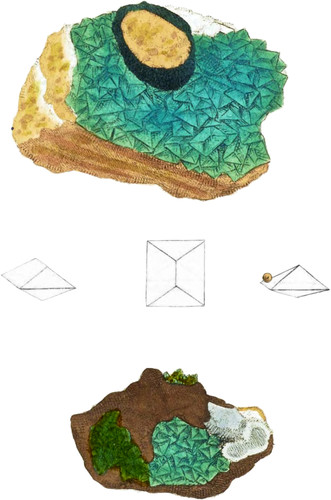 Enlarge
Enlarge
British Mineralogy
Arseniate of Copper
- Class 3. Metals.
- Order 1. Homogeneous.
- Gen. 4. Copper.
- Spec. 9. Arseniate of Copper.
- Div. 1. Crystallized.
- Spec. Char. Arsenic acid combined with copper.
- Syn. Philos. Trans. for 1801, p. 169
We are obliged to Mr. Chenevix and Count Bournon for the best account of the arseniates of copper. They are found at Huel Gorland mine in Cornwall. The simplest variety, according to Count Bournon, is the obtuse octaëdron. He observes that this octaëdron has, in each of its pyramids, two opposite planes more inclined than the other two; which gives a parallelogrammic form to their common base. The two planes which are most inclined to meet at the apex of each of the pyramids, in an angle of 130°, and at the common base in one of 50°. The two planes which are less inclined meet at the apex in an angle of 115°, and at the base in one of 65°.
The faces are sometimes smooth, mostly bright, and occasionally show signs of the angles of the tetraëdron, or have striæ parallel to their edges, as Count Bournon observes. He also remarks that the four planes terminate in one and the same point; but more commonly the apex is formed into a ridge, the octaëdron being lengthened parallel to the lesser inclined planes. The base is then a square, or at least approaches nearly to that form. The first figure seems to be rare; those with the ridge are more commmon, particularly such as are further lengthened, passing from the right hand figure in my Plate to the left*. The gangue is an ochraceous quartz with some copper, and often approaches what is called pitch topper: the right hand figure has a little green globule of a waxy appearance. Such are sometimes abundantly scattered over the octaëral crystals, and appear to be carbonate of copper, or malachite.
It is either of a beautiful deepish azure blue with a greenish cast, exactly resembling pure Roman vitriol, or artificial sulphate of copper somewhat opaque, or of a fine green; in which last case it resembles the emerald. Such specimens are most transparent, and vary in being sometimes lighter coloured. These are frequently blue within, as the fracture readily shows. We shall now consider the present specimens chemically, with the assistance of Mr. Chenevix, who, as well as Count Bournon, remarks the rarity of this substance in any other country; and it appears that Mr. Haüy had only seen the hexaëdral variety of arseniate of copper from Cornwall, in the hands of a friend, when he was about his very ingenious work on crystallography. We therefore may safely conclude that the present and first species of Count Bournon, with all the others, are described in the Philosophical Transactions only, or in works copied from thence. We shall, however exhibit some varieties not yet described, one of which may be seen in the next plate.
That able chemist Mr. Chenevix, having favoured the public with the analysis, found it to contain
| 98 | |
| Oxide of copper | 49 |
| Arsenic acid | 14 |
| Water | 35 |
- * The Count mentions these as the only two varieties he has observed in the form of the crystals of this species, although he had opportunity of examining a great number of specimens. I am happy to add a new, and I think interesting, variety, especially as it seems, from what has been said above, to be very rare. See tab. 32.

